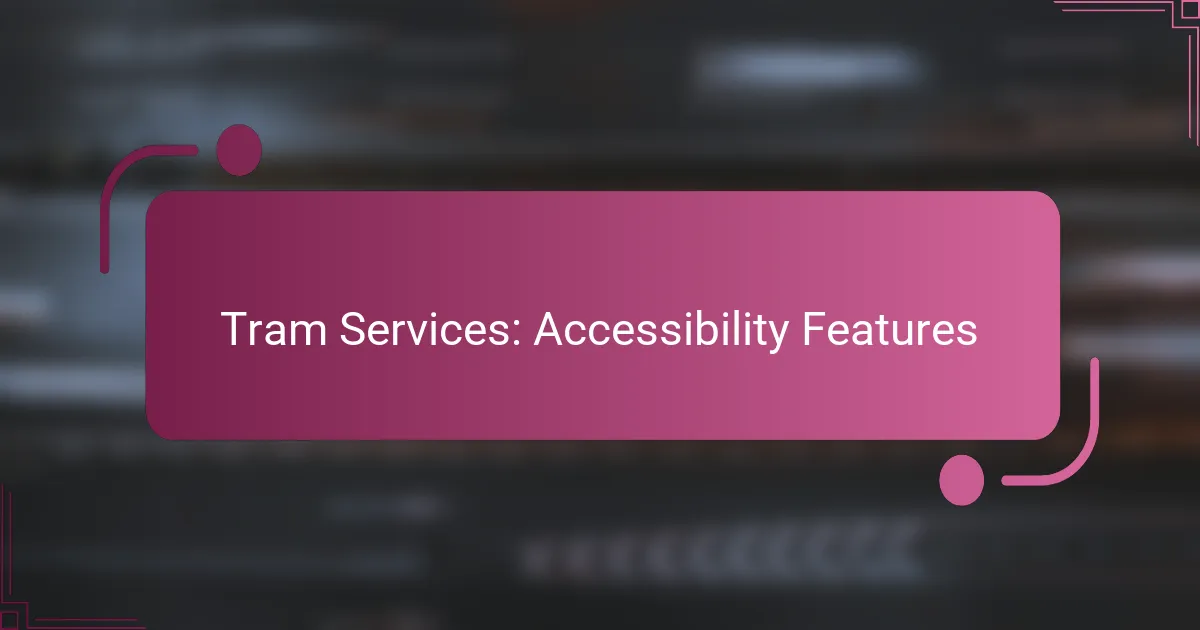Tram services are equipped with various accessibility features to support passengers with mobility challenges and sensory impairments. By incorporating low-floor trams, audio-visual announcements, and designated wheelchair spaces, these services strive to create an inclusive and comfortable travel experience for all users.
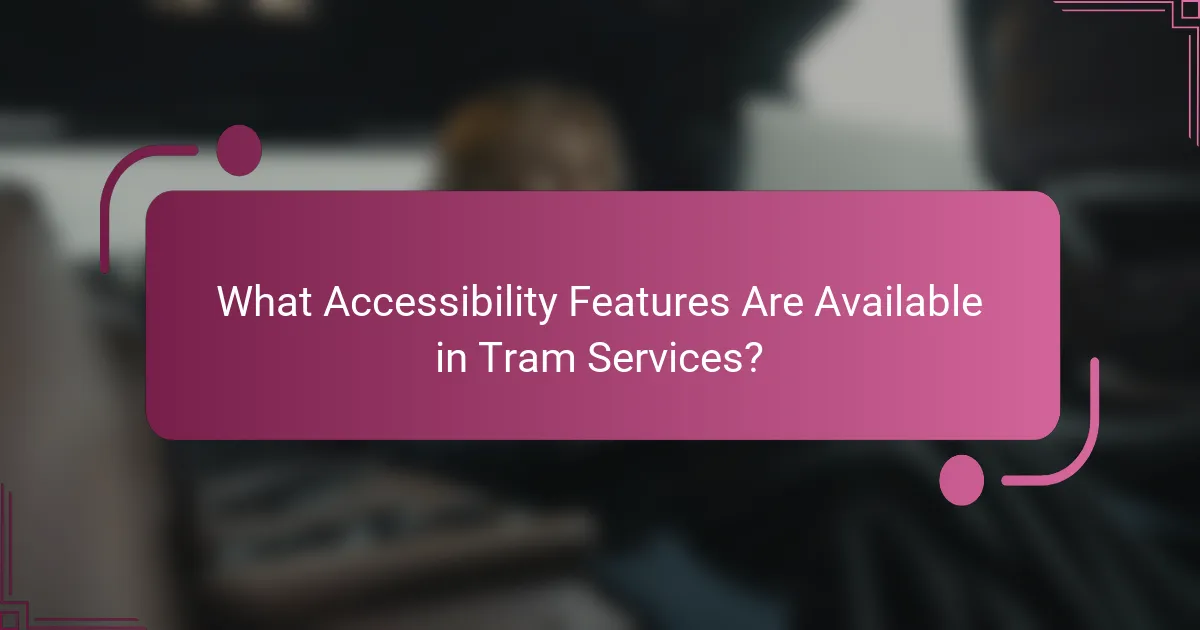
What Accessibility Features Are Available in Tram Services?
Tram services offer several accessibility features designed to assist passengers with mobility challenges and sensory impairments. These features aim to create a more inclusive travel experience, ensuring that everyone can navigate the tram system effectively and comfortably.
Wheelchair ramps
Wheelchair ramps are a critical accessibility feature in tram services, allowing individuals in wheelchairs or with mobility devices to board and disembark easily. Most modern trams are equipped with automatic ramps that deploy at tram stops, ensuring a smooth transition from the platform to the vehicle.
When using tram services, check for signage indicating accessible stops and confirm that the tram you plan to board is equipped with a ramp. If assistance is needed, staff members are typically available to help.
Audio announcements
Audio announcements provide essential information about tram stops and service updates, enhancing accessibility for passengers with visual impairments. These announcements are usually made both before and after each stop, ensuring that all passengers are informed about their journey.
Passengers should pay attention to these audio cues, as they can help in identifying the correct stop. In some systems, announcements may also include information about delays or changes in service, which is crucial for planning travel.
Priority seating
Priority seating is designated for individuals who require additional support, such as seniors, pregnant women, or those with disabilities. These seats are typically located near the doors for easy access and are marked clearly with signage.
Passengers are encouraged to offer these seats to those in need, promoting a respectful and accommodating environment. Tram operators often remind passengers to keep these areas clear to ensure comfort for those who require priority seating.
Visual displays
Visual displays in trams provide real-time information about upcoming stops, service changes, and other important announcements. These screens are especially beneficial for passengers who are hard of hearing or prefer visual information.
Familiarizing yourself with the layout of the tram and the location of these displays can enhance your travel experience. Look for screens that indicate the next stop and any relevant service updates during your journey.
Assistance for visually impaired
Tram services often provide assistance for visually impaired passengers, including tactile guidance systems and trained staff to help navigate the tram and its surroundings. Some systems may also offer orientation aids at tram stops.
Passengers who require assistance are encouraged to inform the tram staff upon arrival. Many tram services have protocols in place to ensure that visually impaired individuals receive the support they need to travel safely and confidently.
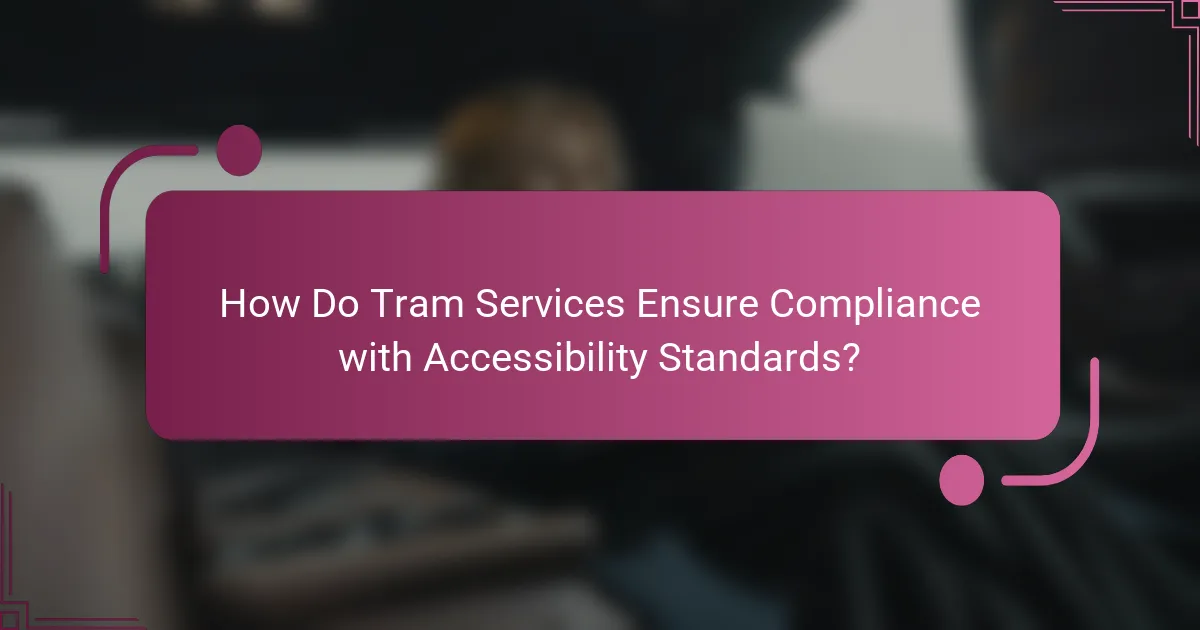
How Do Tram Services Ensure Compliance with Accessibility Standards?
Tram services ensure compliance with accessibility standards by implementing features that accommodate passengers with disabilities. These features include low-floor trams, audio-visual announcements, and designated spaces for wheelchairs, which collectively enhance the travel experience for all users.
ADA compliance in the US
In the United States, tram services must adhere to the Americans with Disabilities Act (ADA), which mandates accessible public transportation. This includes requirements for vehicle design, such as ramps or lifts for wheelchair access, and proper signage to assist visually impaired passengers.
Trams must also provide adequate training for staff on how to assist passengers with disabilities. Regular audits ensure compliance with these standards, helping to maintain a consistent level of accessibility across services.
Accessibility regulations in the UK
In the UK, tram services are governed by the Equality Act 2010, which requires public transport to be accessible to all users. This includes features like step-free access, priority seating, and clear communication of service information for those with hearing impairments.
Operators must conduct regular assessments to ensure compliance with these accessibility regulations, making necessary adjustments to improve service for individuals with disabilities. Local authorities often collaborate with tram operators to enhance accessibility features further.
Local government guidelines
Local governments play a crucial role in establishing guidelines for tram service accessibility. These guidelines often reflect national standards while addressing specific community needs, such as the inclusion of tactile paving and audible signals at tram stops.
Tram operators should actively engage with local authorities to ensure that their services meet these guidelines. Regular feedback from passengers with disabilities can help identify areas for improvement and ensure that accessibility remains a priority in service planning.

What Are the Benefits of Accessible Tram Services?
Accessible tram services provide significant advantages by ensuring that all individuals, including those with disabilities, can use public transportation effectively. These benefits include increased ridership, enhanced community inclusion, and improved public perception of the tram system.
Increased ridership
When tram services are accessible, they attract a broader range of passengers, including those with mobility challenges. This can lead to a noticeable increase in overall ridership, as more people feel confident using the service. Cities that implement accessibility features often see ridership growth in the double digits.
Accessibility improvements can include features like low-floor trams, ramps, and designated seating areas. By making these changes, tram operators can cater to the needs of elderly passengers, parents with strollers, and individuals using wheelchairs.
Enhanced community inclusion
Accessible tram services foster a sense of belonging within the community by allowing everyone to participate in social, educational, and economic activities. When transportation is inclusive, it enables individuals with disabilities to access jobs, healthcare, and leisure activities without barriers.
For example, a well-designed tram system can connect various neighborhoods, ensuring that all residents, regardless of their physical abilities, can engage with local events and services. This inclusivity strengthens community ties and promotes a more cohesive society.
Improved public perception
Implementing accessible features in tram services can significantly enhance the public’s perception of the transportation system. When a tram network is seen as inclusive, it reflects positively on the city’s commitment to equality and social responsibility.
Positive public perception can lead to increased support for funding and expansion of tram services. Communities that prioritize accessibility often enjoy a reputation as progressive and welcoming, which can attract tourism and new residents.
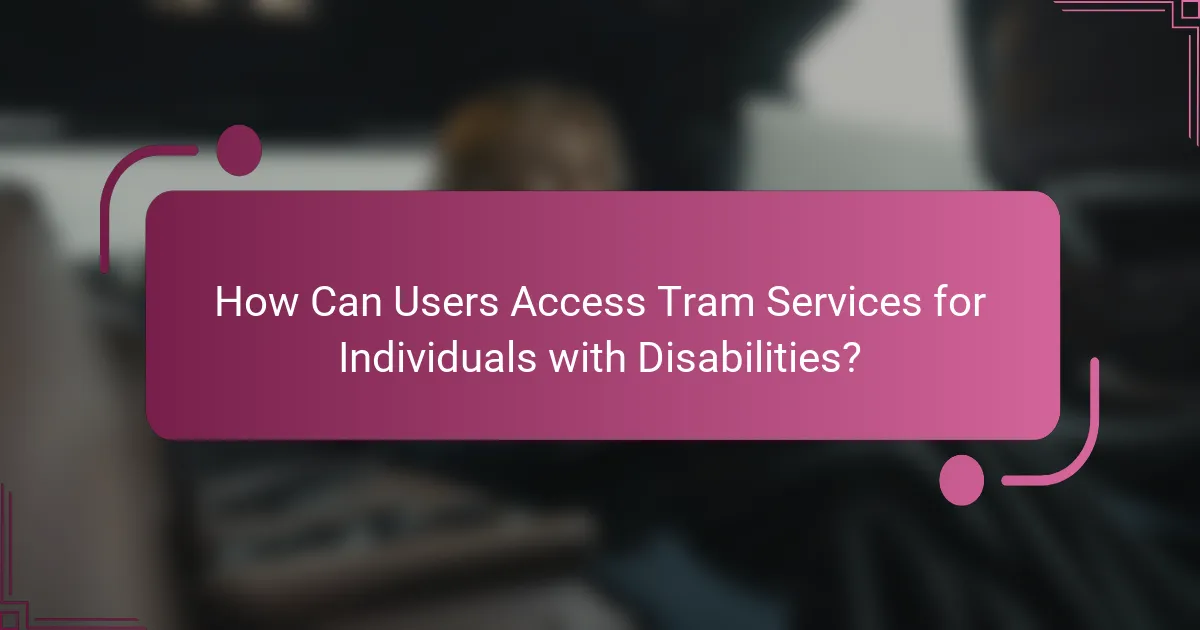
How Can Users Access Tram Services for Individuals with Disabilities?
Users can access tram services designed for individuals with disabilities through various features that enhance convenience and support. These include online booking systems, dedicated customer service lines, and mobile apps that provide real-time updates on tram schedules and accessibility options.
Online booking systems
Online booking systems allow users to reserve tram services in advance, ensuring that accessible options are available when needed. Many tram operators offer websites or platforms where users can select specific accessibility features, such as wheelchair spaces or assistance services.
When using online booking, it’s essential to check the time frame for reservations, as some systems may require bookings to be made at least a few hours in advance. Familiarizing yourself with the interface can streamline the process and reduce potential issues on the day of travel.
Dedicated customer service lines
Dedicated customer service lines provide direct support for individuals with disabilities, offering assistance with inquiries about accessibility features and services. These lines are often staffed by trained personnel who can guide users through the booking process or address specific concerns.
It’s advisable to have relevant information ready when calling, such as travel dates and specific accessibility needs. This preparation can help customer service representatives provide tailored assistance quickly and efficiently.
Mobile apps for real-time updates
Mobile apps designed for tram services often include features that provide real-time updates on tram arrivals, delays, and accessibility options. These apps can be particularly useful for individuals with disabilities, as they can help plan journeys more effectively and avoid unnecessary waiting times.
Users should explore the app’s features, such as notifications for service changes or alerts for accessible tram services. Regularly checking the app before travel can enhance the overall experience and ensure that users are informed of any last-minute changes.

What Are the Costs Associated with Implementing Accessibility Features?
Implementing accessibility features in tram services involves various costs, including initial investments for infrastructure, ongoing maintenance expenses, and potential funding sources. Understanding these financial aspects is crucial for effective budgeting and planning.
Initial investment for infrastructure
The initial investment for accessibility infrastructure can vary significantly based on the existing tram system and the extent of upgrades needed. Typical costs may range from thousands to millions of dollars, depending on factors such as station modifications, vehicle retrofitting, and installation of ramps and elevators.
For example, installing a new accessible tram stop may cost between 50,000 to 200,000 USD, while retrofitting existing vehicles can range from 10,000 to 50,000 USD per tram. Planning for these expenses early can help secure necessary funding and avoid budget overruns.
Ongoing maintenance costs
Ongoing maintenance costs for accessibility features are essential to ensure they remain functional and effective. These costs can include regular inspections, repairs, and updates to equipment such as elevators and ramps.
Typically, maintenance expenses can account for 5-15% of the initial investment annually. For instance, if a tram system invests 1 million USD in accessibility upgrades, it may budget 50,000 to 150,000 USD each year for maintenance. Consistent funding for these costs is vital to maintain compliance with accessibility standards.
Funding sources and grants
Various funding sources and grants are available to support the implementation of accessibility features in tram services. Government programs, non-profit organizations, and local municipalities often provide financial assistance aimed at enhancing public transport accessibility.
For example, in the United States, the Federal Transit Administration offers grants specifically for accessibility improvements. Additionally, local governments may have their own funding initiatives. Researching and applying for these grants can significantly reduce the financial burden on tram operators.
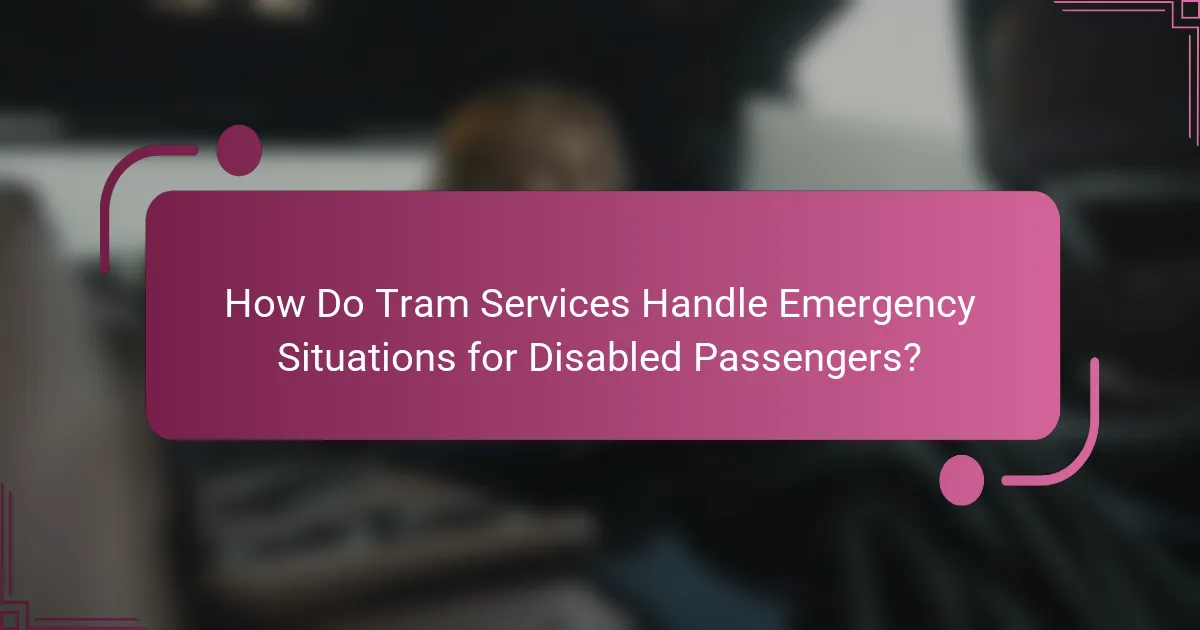
How Do Tram Services Handle Emergency Situations for Disabled Passengers?
Tram services implement specific protocols to ensure the safety and accessibility of disabled passengers during emergencies. These measures include trained staff, accessible emergency exits, and communication systems tailored for individuals with various disabilities.
Emergency Training for Staff
Staff members receive specialized training to assist disabled passengers during emergencies. This training covers evacuation procedures, the use of accessibility equipment, and how to communicate effectively with individuals who may have hearing or visual impairments.
Regular drills are conducted to keep staff prepared for real-life scenarios. These drills often simulate various emergency situations, allowing staff to practice their responses and ensure they can assist passengers efficiently.
Accessible Emergency Exits
Trams are designed with accessible emergency exits that accommodate wheelchairs and other mobility aids. These exits are clearly marked and equipped with features such as ramps or wide doors to facilitate quick evacuation.
In addition, emergency signage is provided in multiple formats, including braille and large print, to ensure that all passengers can understand evacuation routes and procedures.
Communication Systems
Effective communication is crucial during emergencies. Tram services are equipped with audio and visual alert systems to inform passengers of any situation that may arise. These systems are designed to be easily understood by individuals with different disabilities.
Some trams also offer personal communication devices for passengers who may need assistance, allowing them to alert staff directly in case of an emergency. This ensures that help is readily available when needed.
